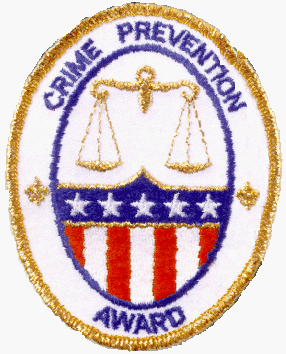PLEASE NOTE: BSA has reduced their emphasis on this program, but has not discontinued it completely. The patch is still being produced, but some Scout Shops™ may not routinely stock the patch. To avoid disappointing Scouts, CHECK FIRST to see if any are available in your area before promoting this program and patch.
To the Parent or Unit Leader
The Boy Scouts of America’s Crime Prevention Program assists neighborhoods and communities in their efforts to prevent crime.
Youth
When working on crime prevention with youth, help them learn the importance of the following:
- Settle arguments with words, not fists or weapons. Do not stand around and watch while others are arguing; violence often spreads into groups of bystanders.
- Learn safe routes and good places to find help in the neighborhood. Trust your feelings; if you sense danger, get away fast. Report any crimes or suspicious actions or individuals to the police, school authorities, or parents.
- Do not open the door to anyone you do not know and trust. Never go anywhere with someone you do not know and trust.
- Whenever you leave home, tell parents, relatives, or other responsible adults where you are going, who you will be with, and when you expect to be home.
- Do not use alcohol or other drugs.
- Stick with friends who are not violent and who do not use alcohol or drugs. Avoid known "trouble spots" and difficult situations.
- If someone tries to abuse you or touch you inappropriately, yell no, get away, and tell a trusted adult.
- Get involved in making your neighborhood safer. Join with your neighbors, neighborhood associations, and local schools in these efforts.
- Help teach younger children how to avoid being victims of crime. Set a good example for them, and explain why it’s important to be safe.
Family
Addressing crime prevention through families is one of the most effective ways to combat the problem. Here are some important topics for family or one-on-one discussion:
- Children need to feel that someone cares enough to protect them. Adults need to set limits, rules, and standards for children. Discuss the reasons for and importance of these boundaries.
- Children need to talk about violent situations they might witness or be involved in. How might such violent situations be avoided? How can children prevent such situations from happening to themselves or their family and friends? What is a loving and supportive environment, and how is it created?
- Why is it important to be trustworthy? How does a person earn a reputation for trustworthiness? How does a person lose that reputation, and what does it feel like? Discuss how one small violation of trust can lead to larger ethical compromises.
- Is it right to "narc on" someone you know? How does silence allow crime to flourish? Discuss ways to tell the truth about someone else’s actions without suffering reprisals. Give examples.
- It can be difficult to develop a sense of respect and appreciation for one’s family, community, and world. Discuss focusing on positive things-not just problems.
The following strategies and projects can involve individuals or whole families in preventing crime:
- Don't keep or temporarily place weapons where children have access to them A parent's attitude and example can be extremely influential when it comes to weapons.
- Get to know neighbors and help your children develop trust with them. Increase the awareness of everyone in your neighborhood of situations that could attract crime - for example, empty houses, open garage doors, unaccompanied children.
- Stay in touch with your children and have them stay in touch with you. Teach them how to contact you and how to find another trusted adult any time they need help.
- Offer the use of your home as a refuge and a reliable source of help for children who are frightened or need assistance.
- Organize, join, or participate in your neighborhood’s or community’s crime watch efforts. Help educate others about crime prevention.
Neighborhood/Community
When you focus on community crime prevention, consider participating in the following programs:
- Neighborhood watch
- Child identification
- The McGruff program
- Safety for elderly people
- Local police or sheriff’s department initiatives
- Church- or school-based anticrime initiatives
Consider these suggestions for crime prevention projects:
- Work with local schools and parks to establish drug-free, weapon-free zones. Build a partnership with police. Focus on solving problems instead of reacting to crises.
- Help develop community pride by cleaning up the neighborhood. Involve the whole community. Contact the departments of public works or parks and recreation for specific ideas, guidance, or suggestions.
- Build a phone list of local organizations that offer counseling, job training, guidance, and other services that provide positive options to at-risk youth and families. Distribute the list in your neighborhood using local libraries, recreation centers, and other facilities.
The Crime Prevention Award
Recognitions consisting of patches, wallet cards, certificates, and pins are available. All participants-including those not registered in Scouting-are eligible to earn the Crime Prevention Award provided they fulfill the requirements of the two phases outlined below and detailed on the application form.
Phase I-Youth and Family
Youth and family members fulfill this phase of the award by completing the activities outlined on the application form for this phase, and having a parent and/or unit leader sign the application form afterward.
Phase II-Youth and Unit
This phase of the award is completed by
- Securing the approval of a unit leader for a crime prevention project, either an original project or a project of a neighborhood- or community-based organization;
- Participating with your unit, den, patrol, friends, family, neighborhood, or community in the crime prevention project; and
- Having a parent and/or unit leader sign the application form afterward.
Once both phases have been completed, the unit leader must sign the application. Awards may be purchased at the local council service center.








